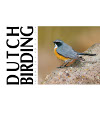Dutch Birding volume 36 (2014) no 5

Common Grackle over Kamperhoek in April 2013
On 8 April 2013, a Common Grackle Quiscalus quiscula was seen by five observers as it flew north-east over migration watchpoint Kamperhoek near Swifterbant, Flevoland, the Netherlands. Size and proportions, pale eye, strong bill and wedge-shaped tail all pointed at Common Grackle, while the strong contrast between glossy blue head and neck and glossy brown body was typical of the migratory subspecies Q q versicolor (Bronzed Grackle). Age and sex could not be determined with certainty; females are slightly smaller than males and show less gloss. Based on the large amount of gloss in the plumage and the triangular appearance of the tail in side view it was probably a male.
The bird was accepted by the Dutch rarities committee (CDNA) as the first for the Netherlands. Within the Western Palearctic (WP), only one other record is known, at Gevninge, Sjælland, Denmark, from late March to c 20 April 1970. This record was, however, not accepted by the Danish rarities committee. The reason for this is not entirely clear; from what can be traced after so many years it seems that this bird showed no signs of captivity.
Common Grackle is a common to abundant species in a large part of North America east of the Rocky Mountains. Along the East Coast it migrates north between mid-February and mid-April. Bronzed Grackle is a migrant that breeds in Canada (eg, on Newfoundland) and in a large part of the USA and winters south in Texas, USA. Northern birds tend to migrate the furthest ('leap-frog migration'). The species is regularly found outside its normal range, for example along the West Coast of the USA and north of its breeding range in Canada. Interesting records are those (of Bronzed Grackles) collected near Wainwright, Alaska, USA, on 17 June 1943 and near Barrow, Alaska, from 24-27 June 2012, c 2000 km north-west of the closest breeding areas. There are also several records known from Bermuda (c 1000 km off North Carolina, USA) where an influx took place in March-April 2003, with for example 12 individuals on 11 March and 20 on 19 March.
Enquiries among bird keepers have not resulted in any documentation of captive Common Grackles in the Netherlands and there are no records of escapes. The species is not on the list of birds that have been bred in captivity in the Netherlands nor has it ever been shown at an avian exhibition. Furthermore, the ban on the import of wild birds into the European Union since 2007 makes it unlikely that this species has been imported recently. Exporting wild birds from Canada and the USA is forbidden without appropriate permits.
More than 80 species of North American landbirds have been recorded in the WP and the number is still growing. Their occurrence, especially in autumn, is strongly linked to fast-moving weather systems across the Atlantic Ocean. Possibly, the bird arrived in Europe in autumn and was trying to find its way back north. Common Grackle's range and migration are similar to those of some other passerines that have occurred as vagrants, in particular of Song Sparrow Melospiza melodia and Brown-headed Cowbird Molothrus ater. Unlike many other species, these predominantly appear in spring (as most other American sparrows recorded in the WP) and have not yet been recorded in the Azores, Iceland and Ireland - prime sites for Nearctic autumn vagrants. Other North American medium-distance migrants that have been recorded in the Netherlands are Belted Kingfisher Megaceryle alcyon, Northern Mockingbird Mimus polyglottos, American Robin Turdus migratorius, Song, White-crowned Zonotrichia leucophrys and White-throated Sparrow Z albicollis, Dark-eyed Junco Junco hyemalis and Yellow-headed Blackbird Xanthocephalus xanthocephalus. Compared with Yellow-headed Blackbird, the nearest breeding areas of Common Grackle are situated c 2000 km closer to Europe.
Roy Slaterus, Bervoetsbos 71, 2134 PM Hoofddorp, Nederland
(roy.slaterus dutchbirding.nl)
dutchbirding.nl)
terug






